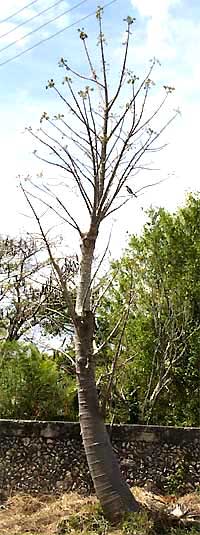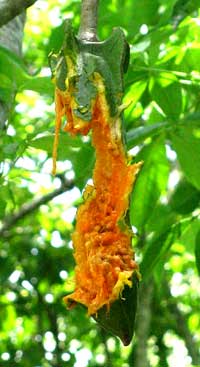BONETE
When you see what looks like a small fruit tree sprouting from a gigantic elephant's leg -- like the dry-season-leafless shown below at the right -- probably it's what the Maya call Bonete. I find no English name for it. It's Jacaratia mexicana, endemic but frequent in the Mexican states of Yucatan and Campeche, and growing to about 40 feet high (12m). Bonetes are members of the Papaya Family.
 Bonetes flower in the middle of the dry season, in January or so. The male flowers are yellow and attractive, but the female ones are more interesting, being star shaped and bearing oversize, brown stigmas. The ovary bears longitudinal ridges along its sides. Those ridges will develop into "fins" on the Bonete's torpedo-shaped fruits, as shown below:
Bonetes flower in the middle of the dry season, in January or so. The male flowers are yellow and attractive, but the female ones are more interesting, being star shaped and bearing oversize, brown stigmas. The ovary bears longitudinal ridges along its sides. Those ridges will develop into "fins" on the Bonete's torpedo-shaped fruits, as shown below:

The fruits grow to about six inches long (15cm) and may yellow. The local Maya eat them raw, saying that they are sweet. The fruits take their time to ripen, about six months. Often by the time they ripen, leaves are present on the trees.
 When I first saw the torpedo-like fruits pointed toward the ground and bearing those swooped-back fins, I imagined that when the fruits dropped the fins would stabilize their descent and the fruits would lodge nose-down in rainy-season mud. However, you can see the fruit's final destiny at the right.
When I first saw the torpedo-like fruits pointed toward the ground and bearing those swooped-back fins, I imagined that when the fruits dropped the fins would stabilize their descent and the fruits would lodge nose-down in rainy-season mud. However, you can see the fruit's final destiny at the right.
The ripe fruit, still green outside but orangish like ripe papaya inside, remains on the tree while animals eat it. Birds eat them and I suspect that fruit bats also do, and probably Kinkajous and other critters. My Maya friends confirm that the fruits don't fall by themselves. "Use a pole," they advise. Maybe the "fins" serve as holds for animals as they feed on the fruit below them.
Tthe Bonete's leaves emerge at the beginning of the rainy season, cluster toward the tips of branches and are "palmately compound" -- consisting of five to seven slender leaflets arising from atop a stem, or petiole, like fingers from the palm of a hand.
 Bonetes flower in the middle of the dry season, in January or so. The male flowers are yellow and attractive, but the female ones are more interesting, being star shaped and bearing oversize, brown stigmas. The ovary bears longitudinal ridges along its sides. Those ridges will develop into "fins" on the Bonete's torpedo-shaped fruits, as shown below:
Bonetes flower in the middle of the dry season, in January or so. The male flowers are yellow and attractive, but the female ones are more interesting, being star shaped and bearing oversize, brown stigmas. The ovary bears longitudinal ridges along its sides. Those ridges will develop into "fins" on the Bonete's torpedo-shaped fruits, as shown below:
 When I first saw the torpedo-like fruits pointed toward the ground and bearing those swooped-back fins, I imagined that when the fruits dropped the fins would stabilize their descent and the fruits would lodge nose-down in rainy-season mud. However, you can see the fruit's final destiny at the right.
When I first saw the torpedo-like fruits pointed toward the ground and bearing those swooped-back fins, I imagined that when the fruits dropped the fins would stabilize their descent and the fruits would lodge nose-down in rainy-season mud. However, you can see the fruit's final destiny at the right.